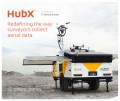RAVI MEHTA, MARKETING MANAGER, AEROMETREX
Artificial intelligence (AI) is often loosely defined and different people look at it in different ways. In its entirety, it is a vast area of research that is developing every day. Put simply, AI is the capacity of a computer to act intelligently as opposed to natural intelligence in humans. This “intelligence” is implemented in the form of algorithms to perform specific tasks, learn, and adapt to provide solutions.
More specifically, Machine Learning (ML) and Deep Learning (DL), both subsets of AI, have come to prominence in the recent past due to the advancements in computing power and abundance
of data. Deep learning utilises end-to-end optimized deep neural networks instead of just classical machine learning algorithms, removing the need for hand-crafted features to define different objects.
How can businesses benefit from geospatial data processed with the help of AI?
Geospatial data derived from aerial surveys can run into several terra bytes covering millions of pixels and objects, in even small areas. Processing this data often requires a combination of manual and automated processes that can run into days & weeks. Today, the ability
to run these through Deep Learning models is not only helping build process efficiencies but also offering users far richer data insights and actionable knowledge.
AI-driven geospatial intelligence is of immense importance to a range of sectors including urban planning, construction & engineering, critical infrastructure, logistics, smart cities and digital twins, game development, etc. Aerometrex’s ability to implement pixel-level classification and segment any object within a 2D or 3D environment using Deep Learning is creating powerful use cases across these industries.

AI powered classification of 3D model
What are some examples of AI-derived outputs and use cases?
Pervious vs Impervious Surface Classification
Aerometrex is using supervised machine learning algorithms to differentiate between permeable and impermeable ground surfaces, using their high resolution 2D aerial imagery. This process, that shall be enhanced further through Deep Learning, is able to semantically segment different surfaces such as roads, grass, etc. Interestingly, neural networks can do this by analysing a combination of visual and non-visual features (such as surface reflection parameters).
Change Detection and Time-series Analysis
Today, power companies and solar installers need to know where solar panels are (or can be placed) and how many. They also want to assess change over time. All these questions can
be effectively solved with AI-driven geospatial data. Similarly, a time-series analysis using AI-derived classification of cars and their density can help retail businesses assess growth in customer footfall over time. Insurance companies need to understand changes to assets such as roofs, solar panels, swimming pools, etc. on a land parcel, especially post disasters such as hailstorms
and bush fires. Deep Learning can provide the critical change detection information to these users in a quick & efficient manner.
Automatic Object Replacement in 3D Models
3D photogrammetry and game engines have come a long way. With the ability of game engines to ingest large 3D datasets, game developers will want
to easily separate & replace specific objects such as trees, cars, buildings, etc. with computer-generated (CG) assets and improve overall texture.
AI-driven semantic segmentation of Aerometrex’s 3D models now makes that possible, allowing the balance between natural environments and ultra-real game objects.
What is the future of geospatial AI?
The key to a robust Deep Learning model lies in the training data. Aerometrex has the capability to generate vast amounts of training data for its own neural networks. It is however not just about quantum of data, but more importantly the variations within these datasets and their quality and annotation accuracy, which has helped the company stay at the cutting edge of artificial intelligence in the geospatial space.
Aerometrex’s goal is to be able to classify all objects within their 2D maps and 3D models, leaving nothing as unclassified. Furthermore, the company is engaged in sub-object level, fine-grained semantic segmentation, for example, to classify building furniture such as windows, chimneys, roof types, solar panels, etc. This shall allow businesses to query geospatial data for objects that meet very detailed & specific criteria within a 2D or 3D map, building truly intelligent spatial knowledge.
Information provided by Aerometrex.













